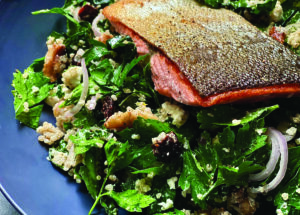Support Brain Health
Simple ways to add to your wellness routine


(Family Features) When most people think of wellness, diet and exercise are the first things that come to mind. Brain health is another essential element of your overall wellness because it affects your quality of life in many ways.
Brain health is the foundation of your ability to live a productive and successful life by communicating and solving problems. It’s the driving force behind your daily function.
Give your brain extra support with these tips:
Stimulate Your Mind
Like any muscle, your brain needs exercise. Your workout equipment for your brain can include activities like puzzles, reading, learning an instrument, taking up a new hobby or learning a new language.
Focus on Brain-Supporting Foods
What you eat doesn’t just affect your physical health; it affects your brain health, too. One example is the Mediterranean-DASH Intervention for Neurodegenerative Delay (MIND) diet, which is the result of more than 20 years of data collected by researchers at Rush University Medical Center and Harvard School of Public Health.
It follows the Mediterranean style of eating whole foods with minimal processing and includes an emphasis on plant-based foods, including leafy greens, whole grains and heart-healthy legumes along with some fish and smaller amounts of poultry. The MIND diet aims to build on these principles and emphasizes antioxidant-rich berries, dark leafy greens and fatty fish like salmon, mackerel, herring or sardines.
A dish like Kale and Quinoa Bowl with Salmon reflects the MIND diet guidelines and is a delicious and smart way to support your brain with good nutrition.
“Fueling your brain starts with your plate,” said Melissa Halas, MA, RDN. “This tasty kale, quinoa and salmon recipe by Alton Brown has smart ingredients that match the MIND diet. Plus, the results are delicious. It’s so important to support your brain with the right nutrients.”
Sleep Well
While you catch up on your rest, your body is hard at work rejuvenating all your systems, and your brain is no exception. Getting plenty of sleep each night gives your brain time to repair itself so you wake feeling sharp and focused.
Add a Supplement to Your Daily Routine
Most people fall short of reaching recommended nutrient levels with their diets alone. Supplements can help fill the gap. An option like Neuriva Plus can help support the key indicators of brain health: reasoning (think and understand things in a logical way), focus (zoom in and filter out distractions), accuracy (react with greater speed and precision), memory (record and recall stored information), learning (retain new information) and concentration (concentrating on tasks for longer periods).*
*These statements have not been evaluated by the Food and Drug Administration. This product is not intended to diagnose, treat, cure or prevent any disease.
Available in capsules and gummies, the Neuriva brain health supplements include naturally sourced ingredients like NeurofactorTM (coffee cherry extract) and plant-sourced phosphatidylserine (PS), as well as B vitamins to support brain health.
“I recently turned 60 and over the past couple of decades, I’ve been very focused on taking care of my health from the inside out – first with my food, and now taking action to support my brain health,” said Alton Brown, award-winning chef and food geek. “Neuriva fits perfectly into my holistic regimen, which for me, is just simple life practices, like exercising, eating a balanced diet and getting a good night’s sleep.”
Manage Stress
Keeping your stress in check is good for your mental well-being, but it also affects your physical and cognitive health. Practicing yoga, meditation or listening to music are some ways to reduce stress while improving your cognitive function and performance.
Connect with Others
Personal interaction also sharpens your brain, as it encourages you to practice communication and other cognitive skills. You can protect and improve your brain health by creating and nurturing connections with friends and family.
Keep Moving
Your brain needs plenty of oxygen for good function. Physical activity burns calories and builds muscle while increasing oxygen flow and stimulating nerve cell growth.
For more ideas to support brain health and wellness, visit Neuriva.com and download the Neuriva Brain Gym app.
Kale and Quinoa Bowl with Salmon
Recipe courtesy of Alton Brown on behalf of Neuriva
Servings: 4

Kale and Quinoa Bowl:
1 bunch lacinato or “dinosaur” kale, stems removed and cut into ribbons (about 4 ounces, stemmed)
1 bunch (1 1/2 ounces) flat leaf parsley, stems removed and roughly chopped
2 shallots, thinly sliced
5 tablespoons extra-virgin olive oil, divided
1 lemon, zest and juice only
2 large garlic cloves, minced
1/2 cup plain, low-fat yogurt
4 ounces firm feta cheese, divided
1 cup (3 1/2 ounces) walnuts, toasted and lightly crushed, divided
1 teaspoon kosher salt
2 cups cooked white quinoa
1/2 cup dried cherries
freshly ground black pepper
Salmon:
2 skin-on salmon fillets (around 1-inch thick and 5 ounces each)
1/2 teaspoon kosher salt
2 tablespoons light olive oil
To make kale and quinoa bowls: In large bowl, toss kale, parsley and shallots with 2 tablespoons olive oil; set aside 10 minutes.
In bowl of food processor, puree remaining olive oil, lemon juice and zest, garlic, yogurt, 2 ounces feta, 1/3 of the walnuts and salt.
Pour dressing over greens then fold in quinoa, remaining walnuts, cherries and remaining feta.
Cover and refrigerate at least 1 hour before serving with several grinds of black pepper.
To make salmon: Wrap fillets in paper towels then heat large cast-iron skillet over medium-high heat 5 minutes.
When skillet is hot, season fillets with salt. Add oil to skillet and carefully tilt to evenly cover bottom. When oil shimmers, slide fillets in, skin-side down, pressing each fillet firmly down with spatula.
Reduce heat to medium-low and cook 3 minutes then cover and cook 2 minutes.
Carefully flip fillets, cover and cook 1 minute, or until fillets reach desired doneness or internal temperature of at least 130 F** on thermometer inserted into centers.
**The United States Department of Agriculture recommends a minimum internal temperature of 145 degrees Fahrenheit.
To serve, separate kale and quinoa mixture into four bowls. Slice each fillet in half and place on top of kale and quinoa.
Content courtesy of Neuriva
Photo courtesy of Getty Images (woman eating at laptop)
Photo courtesy of Getty Images (woman doing a puzzle)
Photo courtesy of Lynne Calamia (Kale and Quinoa Bowl with Salmon)
Source: Neuriva





